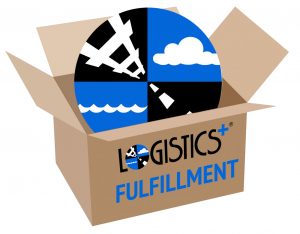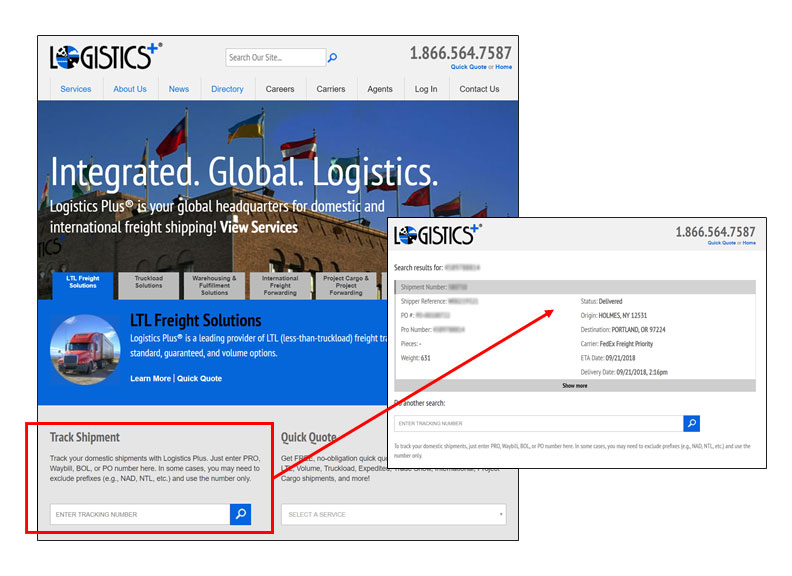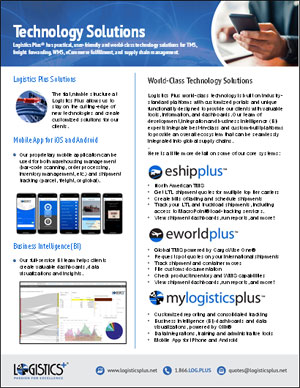
by logisticsplus | Mar 27, 2019 | News
 Business Intelligence (BI) is a technology-driven process for analyzing data and turning it into useful, digestible information. To do this, BI uses a wide variety of tools and applications that allow companies to collect data from internal and external sources to generate dashboards, reports, and visualizations that are easy to understand. The data captured by a business intelligence team is used to help managers, directors, and executives make better informed business decisions. Here are some of the key reasons Business Intelligence is needed in the supply chain:
Business Intelligence (BI) is a technology-driven process for analyzing data and turning it into useful, digestible information. To do this, BI uses a wide variety of tools and applications that allow companies to collect data from internal and external sources to generate dashboards, reports, and visualizations that are easy to understand. The data captured by a business intelligence team is used to help managers, directors, and executives make better informed business decisions. Here are some of the key reasons Business Intelligence is needed in the supply chain:
- Within the transportation and logistics industry, there are millions of data points created each day for every shipment across the world.
- With the option to ship goods via truck, rail, air, ocean, or small pack, it is very difficult to view all of your shipping activity in one place.
- In an increasingly competitive and complex world, the need to find savings and efficiencies is more important than ever.
- When faced with sorting thousands of data points at once, it can be very difficult to understand and make actionable.
How Will Business Intelligence Help Me?
A common term used in business intelligence is Key Performance Indicators (KPI’s). Key Performance Indicators are measurable values that demonstrate how effectively a company is achieving its business objectives. These indicators can be custom crafted to meet customer requirements or industry specifics such as carrier performance, lane utilization, savings and spend optimization, trends and corrective action analysis, and more.
At Logistics Plus, the Business Intelligence team is constantly at work to transform complex data into actionable intelligence for business purposes. Using our customizable Qlik dashboards, we seamlessly integrate all of your shipment data into one place. This easy to use, interactive dashboard has drill-down capabilities that provide powerful and effective insights. The insights from these dashboards can lead to increased efficiency in the supply chain, better warehouse management, and new opportunities for growth. The custom-tailored dashboards exist as an aid to your organization’s strategic and tactical decision making process while providing a way to examine trends from the collected data.
With the help of Business Intelligence, visibility issues can be a thing of the past. From delivery times to delays, having comprehensible data at your fingertips is a must in every supply chain. By working with Logistics Plus, you have the ability to obtain scheduled reports that empower your organization to drive innovation. Contact us today to find out how our Business Intelligence team will help your organization succeed and expand.


by logisticsplus | Oct 10, 2018 | News
 Logistics Plus was recently profiled by VeraCore Software Solutions – a web based order fulfillment software system designed to be at the “core” of fulfillment businesses. Logistics Plus Fulfillment Solutions chose VeraCore to be its complete fulfillment solution because it combines robust order management software with a powerful warehouse management system. VeraCore’s deep capabilities and flexible design helps Logistics Plus meet all of its clients’ needs.
Logistics Plus was recently profiled by VeraCore Software Solutions – a web based order fulfillment software system designed to be at the “core” of fulfillment businesses. Logistics Plus Fulfillment Solutions chose VeraCore to be its complete fulfillment solution because it combines robust order management software with a powerful warehouse management system. VeraCore’s deep capabilities and flexible design helps Logistics Plus meet all of its clients’ needs.
To develop the profile, VeraCore took an in depth look at the ways Logistics Plus utilizes the order management software. As a result of its successes, Logistics Plus and VeraCore have maintained a strong relationship for many years.
You can click the image below to view or download a complete PDF copy of the case study, or by visiting VeraCore online at: http://www.veracore.com/resources/logistics-plus-case-study


by logisticsplus | Sep 23, 2018 | News
As an additional convenience, Logistics Plus customers can now get basic shipment tracking information on the home page of www.logisticsplus.com. Just enter your PRO, BOL, or PO number for any domestic LTL or Truckload shipment into the Track Shipment field (just below the home page banner) to view the status of your shipment. Look for additional enhancements and international shipment tracking in the near future.


by logisticsplus | May 15, 2018 | News
Logistics Plus CIO, Emile Zafirov, was recently interviewed by the Erie Times-News for a small feature in an upcoming edition of its Lake Erie Lifestyle magazine. Here is a full transcript of that interview.
*************************************************************
 How has technology changed LP’s capabilities in the last 5, 10 years?
How has technology changed LP’s capabilities in the last 5, 10 years?
“Technology has become a major differentiator in our industry. So much so, you can say it’s a blurred line between logistics and technology services that we offer. There were several routes our company could have taken seven-eight years ago: stick to core logistics and transportation services, have some basic tech, and compete on price; or, follow a more daring approach by branching out into newer, higher-tech territories and taking on any good challenge that comes our way. We took the latter route. We’ve since faced projects that many other companies would have turned down as too risky, out of their competences, or plain impossible. It takes many things to do it successfully, but two stand out – the ‘art’ and ‘science’ of success for us, if you will. First and foremost – the art – is the spirit of the company, which starts with the CEO of the company, and infects pretty much everyone: the ‘can do’ attitude, ‘don’t be afraid to try something, even if it doesn’t succeed at first’, and ‘care for what you do’ (or as Jim sometimes says, ‘give a s***’ ?). This creates a unique environment that cultivates the right people for the journey. The second – or the science – is much more pragmatic: technology. Heavy focus on technology. We built, acquired and integrated a set of tools into a solid platform that matches the nature and spirit of the company and allows us to be flexible and able to take on the wide variety of projects we do at over two dozens of markets on six continents. During that eight year period, the number of employees in the company grew three times. As a comparison, the size of the IT team grew five times and the BI (Business Intelligence) and Analytics team grew five times just in the last two years.”
 Can you give me some “real” examples of transportation solutions that your team has devised that is directly related to technology that you didn’t have just 5 or 10 years ago?
Can you give me some “real” examples of transportation solutions that your team has devised that is directly related to technology that you didn’t have just 5 or 10 years ago?
“What do you do when your WMS (Warehouse Management System) for a global, high-velocity project, resides in the U.S. and the locations it’s being used from in the field sometimes have no internet access available or the performance is too slow for the high pace of the work? You design your offline mobile application that talks to a local server when it can reach it, which in-turn talks to our cloud servers when it needs to. We could have spent a ton of money on optimizing connections or buying expensive equipment – but we found a better way. Another example are logistics control towers – heavily reliant on visibility into what’s happening in a supply chain and timely input of accurate data. We’ve been doing that for years on some scale but we have become really good at it. Today, with assistance and timely data input by our network of people around the globe, working off the same global logistics platform, we are running global projects out of Erie, PA for some of largest, fastest growing and most demanding companies in the world. Check the website if you’re curious which. “
- What does the future look like? How do you see technology changing the industry in the next decade? What will stay the same?
“The next decade will be very rich with changes. There is a critical mass of knowledge and technology being accumulated as we speak which will result in a much different picture of the industry in the very near future. Quantitative accumulations leading to qualitative transformations. From robotics in warehousing, to drones, to autonomous vehicles and autonomous vessels, to the expansion of e-commerce and crowd-sourcing/Uberisation of last mile delivery of goods to consumers (“would you like us to leave your package in your trunk, or drop it on your balcony on the 17th floor, ma’am?”). What will stay the same is human ingenuity and the constant drive to push the envelope a little further. And that people who care and put their heart in what they do will always do well, and will have even more fun while doing it.”
- Why is it important for companies to have their own technology teams that go beyond fixing computers? What does your BI team do exactly?
“There are many examples of companies outsourcing their technology work and being happy with the results. They ask for something, spec it out, communicate it, and the partner produces it. In a company like ours, where speed, flexibility and resourcefulness are key, IT is logistics, and vice versa. The blurring of the line I mentioned earlier. We are providing one service to the customer that can hardly be split into its components. Sometimes a project starts with the data that the customer wants to see delivered to their system. Then we work our way back to how to produce, where and how we need to plug into the customer’s supply chain and what services we need to provide for them. The only way I know to do that is for the technology team to be an integral part of the company and services it provides. The BI (Business Intelligence) team was sitting with our Truckload team the week before last; they attended a predictive analytics and forecasting workshop in Florida this last week; and they will be sitting with the International Air Freight team next week to figure out some key indicators they can put on a dashboard for the operations managers to look at to better manage their fast moving, multi-legged shipments. Also last week, they delivered a nice report with recommendations on how a customer can change their ordering pace in order to keep less inventory in our warehouses, product by product.”
- How much does technology affect your everyday work?
“Very much. If you sit with us at a sales meeting with a prospective customer, at the LP side of the table you may now see a warehousing specialist, a WMS technology specialist, a development and integrations specialist, and a business intelligence and analytics specialist; but this is still a logistics service Logistics Plus is providing. ?”


by Marketing | Apr 10, 2018 | News

The primary goal of technology innovation is to make tasks less costly and more efficient. This is particularly the case in the logistics field, where capacity is short, labor is scarce, and customer demands more stringent than ever before. There have already been huge improvements made in the logistics industry and things will only progress as modernization continues to evolve. Here is a quick look at 6 technology trends for 2018 and beyond, the roles they play in logistics, and how they may shape the future.
Trends for 2018 and Beyond
1. Robotics & Automation
Forklifts have been a vital component to warehouses for decades, and we’re now seeing a shift toward programming this share of the supply chain. The primary goal is improved efficiency. Amazon is a leading example in this space, thanks to its acquisition of Kiva Systems, now known as Amazon Robotics. As Amazon and other companies have shown, implementing robotics and autonomous machinery into the fold can condense delivery times to just a 24 to 48-hour period. Autonomous forklifts and robots can pick products much sooner than humans, which means companies don’t have to pay human forklift operators. The combination of lower costs and a speedier assembly is a dream come true for any business owner.
2. Safety and Cybersecurity
Safety and logistics will also be on the radar in 2018. Recent hacks into national companies have exposed potential cybersecurity threats throughout some of the most protected organizations on the globe. As a result, logistics providers will be concentrating more on safety. Amplified demand for faster turnaround will also have an inevitable result of increasing the risk of accidents in transportation operations. Workers are going to be functioning quicker, and doing things faster tends to result in less-than-safe practice. National governing agencies also recognize that logistics companies will be doing overtime in 2018, so it is more likely that they will pass protocols sooner rather than later. This will require the use of more innovative analytics to monitor employee performance and obey safety standards.
3. Mobile Apps
The growth of new technologies and the Internet of Things (IoT) will promote logistics service providers and shippers to increase adoption of mobile apps. These types of apps exist for inventory management, barcode scanning, fleet management, shipment tracking, order management, customer service and more. Logistics businesses can pull information and capabilities via an app to manage capacity and satisfy demand. Freight sharing apps are one of the prime app groupings that will see a significant boost throughout 2018.
4. Transportation Management Systems
The adoption and implementation of transportation management systems (TMS) is anticipated to climb in 2018 and beyond. A TMS has the value of being a “hub” for all logistics communications and processes, including route scheduling and optimization, freight auditing and payment processing, carrier management and more. Furthermore, TMS applications have shifted from terminal-based installs to cloud-based platforms, reducing postponements in implementation, removing bottlenecks from downtime and refining cybersecurity simultaneously. As a result, more companies will adopt such solutions throughout the year to keep up with growing demand and to integrate into the amplified use of the other logistics technology trends.
5. Artificial Intelligence
The potential to utilize Artificial Intelligence (AI) to improve decision making, transform business models and networks, and modify the customer experience will drive the payoff for digital enterprises. A recent industry survey indicated that 59% of establishments are still assembling data to shape their AI tactics, while the rest have already made advancements in directing or implementing AI solutions. While using artificial intelligence appropriately will result in a great digital business reward, the promise of general AI to perform any intellectual duty that a human can do, and vigorously absorb and comprehend as much as humans, is uncertain.
6. Blockchain Technology
Blockchain is a public, dispersed, and decentralized archive that eliminates business friction by being autonomous of individual applications or contributors. The technology has the promise to transform industries, including the government, healthcare, content dispersal, supply chain and more. An applied approach to blockchain requires a clear understanding of the business opportunity, the draw backs, a dependable architecture, and a solid implementation strategy. BiTA (Blockchain in Transport Technology) is an organization that is leading the charge to help develop and set standards for blockchain technology within the transportation industry.
If you’re looking for world-class technology solutions, look no further than Logistics Plus. Our technology is built on industry-standard platforms with customized portals and unique functionality designed to provide our clients with valuable tools, information, and dashboards. Our team of development, integration and business intelligence (BI) experts integrate best-in-class and custom-built platforms to provide an overall ecosystem that can be seamlessly integrated into global supply chains.


 Business Intelligence (BI) is a technology-driven process for analyzing data and turning it into useful, digestible information. To do this, BI uses a wide variety of tools and applications that allow companies to collect data from internal and external sources to generate dashboards, reports, and visualizations that are easy to understand. The data captured by a business intelligence team is used to help managers, directors, and executives make better informed business decisions. Here are some of the key reasons Business Intelligence is needed in the supply chain:
Business Intelligence (BI) is a technology-driven process for analyzing data and turning it into useful, digestible information. To do this, BI uses a wide variety of tools and applications that allow companies to collect data from internal and external sources to generate dashboards, reports, and visualizations that are easy to understand. The data captured by a business intelligence team is used to help managers, directors, and executives make better informed business decisions. Here are some of the key reasons Business Intelligence is needed in the supply chain:


 Logistics Plus was recently profiled by
Logistics Plus was recently profiled by 





